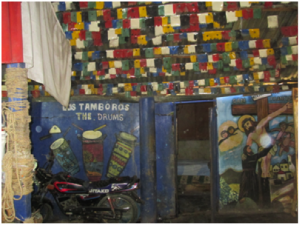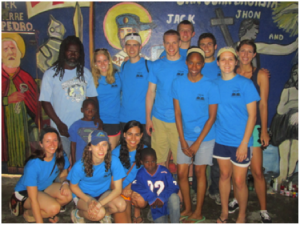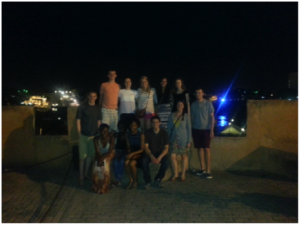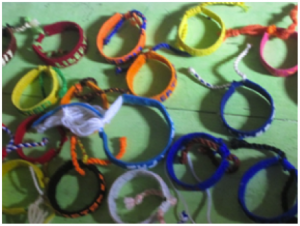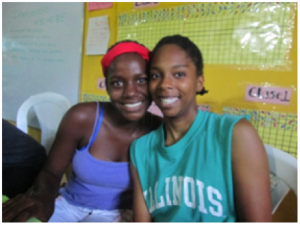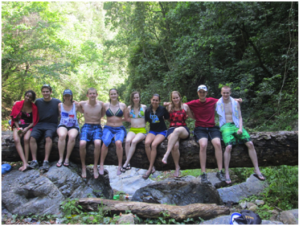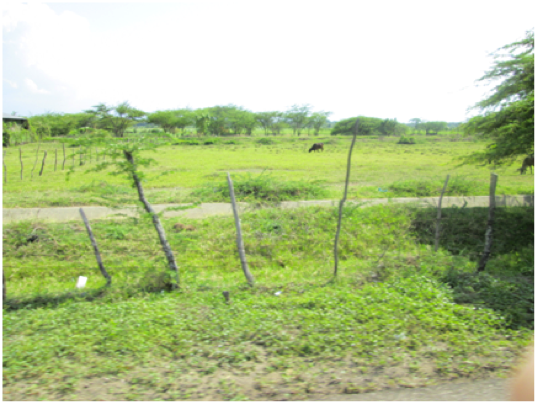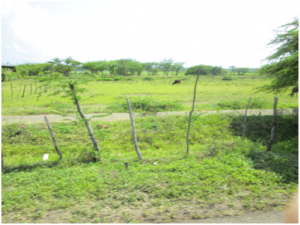After waking up at an early hour to the lovely chorus of roosters, Camille and I couldn’t locate anyone to give us the keys to the latrine. Therefore, we grappled over the following: to use the bucket or not to use the bucket? At that moment, we didn’t get to decide because we discovered a rooster in our bedroom!
April fools.
But seriously, we ended up using the bucket. Like many other things I’d already begun to discover about the quirks of Batey living, it ain’t that bad, and it’s possibly very liberating. I’d add my morning bucket shower to that list as well; not only was it peaceful and enjoyable (despite the decorative spider webs), but I got squeaky clean without wasting tons of water.
After breakfast, the UD group and Yspaniola volunteers all gathered to head out to La finca (the farm) a short walk opposite of Batey Libertad and across the highway. There we toured the fields and visited the adjacent rice factory.
Camilo, my host brother and a Yspaniola volunteer, along with Dana, the local program manager, primarily led the tour. First we stopped at the beginning of la finca, in front of the rice fields, and here’s some of what we learned:
· We were visiting during the off-season, where the rice was still growing. There is no need for workers during this time as there is nothing to plant or harvest.
· The area along the highway has 21 rice factories, hence why this area of the Dominican Republic is known as “the bread basket”.
· Many Haitians work in the rice field, planting, where they are paid per tarea (large row of rice). Pay is around 500 pesos, or about $10.
· This job does not include any type of health insurance or benefits, meaning that should a worker who plants barefoot in the mud get cut by a the glass-like shell of a snail, they may be thrust into a serious situation.
· Dominicans who work on the rice fields often get paid more for doing the easier jobs, such as overseer work.

The rice field
Our next stop was the rice factory, directly across from the first rice field we visited. This factory was only one building big, but contained all the machinery necessary to shell, separate, and package various types and qualities of rice. Below are pictures of the factory as well as brief descriptions of the process:

Rice that needs to be de-shelled, done so by the machinery in the background.
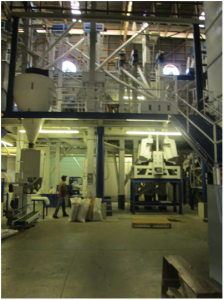
Area where rice is separated and packaged; short grain rice determined to be insufficient is not wasted but instead sold as food for animals.

Rice packaged and labeled by quality/type.

The control panel with ALL THE BUTTONS!
We happened to run into the son of the owner of the rice factory, who informed us that they export their rice around the world and keep some in the Dominican Republic as well. They even have a rice exchange with the US! So cool!
Walking along the dirt path with a gorgeous mountain backdrop, we enjoyed seeing the other crops that are grown on la finca, including plantains, bananas, pidgeon peas, and ahí picante (hot peppers). A few brave and foolish souls decided to pick the ahí picante off the vine and eat it together at the same time. Luckily, I managed to catch the before and after moments:
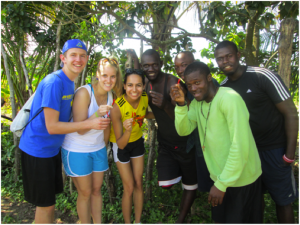
Before the realization that water will not subdue the burning of the deceptive ahí picante.

At this point I was glad to be the cameraman and not the participant.
According to the daring Eric Wiscount, who confronted the ahí picante head on, “That was the hottest thing I’ve ever eaten my life.” Ladies and gents, in this battle of man vs. food, ahí picante won (Man vs. Food reference, anyone?).
After returning to Batey Libertad and enjoying a delicious lunch of arroz con pollo, I regrouped under the gazebo area with the volunteers to play cards (namely, the game know as B.S./cheat – I recommend a quick Google search if you’ve never played). While not everyone partook, we did have many spectators, both adults and kids. However, some of the girls were more interested in braiding my hair than watching the game.
I did particularly take a liking to the hair-do of my 7-year-old host sister, Dawenza, who braided my hair in four or five separate plaits. I rocked that style for a good portion of the card game, until an older girl braided my hair neatly into two plaits. Later in the afternoon, my hair was taken over by three young girls. As a testimony to their combined hairstyle, the outcome can be summarized by this exchange between a young girl and myself:
Girl: “¿Cómo te llamas?” (What’s your name?)
Me: “Me llamo Juli.” (My name is Juli.)
Girl: “¿Porqué tu cabello es tan feo?” (Why is your hair so ugly?)
Some people may find the honesty horrifying, but I found it hilarious. Letting kids braid my hair is nothing new, and the outcome is always pretty similar. Plus, I really didn’t mind it (well, only until I had to detangle the tiniest of braids using massive amounts of conditioner).
At around 2 o’clock, we gathered for our presentation of Deportes Para La Vida, with Camilo leading the session. Deportes Para La Vida (DPV) is a peer-led program geared towards educating youth about HIV/AIDS through games. The activities that day were appropriate for all ages present, including the younger ones. First we started with an easy, routine warm-up activity to get everyone upbeat and focused. It involved counting fingers and toes in a fast paced, fun fashion. Next, we played another super exciting warm-up game, one that I actually used to do as a theater warm-up. We then dove into the main game, which held the significance of the lesson.
Splitting half and half, two groups lined up facing each other, with each person standing shoulder to shoulder with his hands behind his back. One group was given a tennis ball to pass back and forth during a short song, concealing the ball’s location as best as possible. At the call to stop, the other group had three chances to guess who had the ball. After one round, we added a metaphor to the game; the ball represented AIDS, and whoever ended up with the ball was the person with the hypothetical AIDS. This showed that unlike stereotypes, which base who has AIDS on outward appearances, in actuality, you cannot judge if someone has AIDS by how they look. The only way to know is through a test.
Unfortunately, I was so into DPV that I didn’t even take photos, so instead I’m going to provide you with a picture of the UD group with some of the Yspaniola volunteers under the highway sign for Batey Libertad:
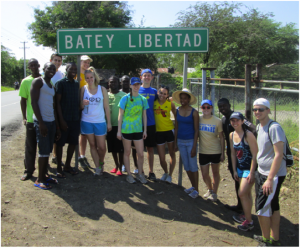
An amazing bunch
Resource creation and observing in the Learning Center were next up on the list of things to do. During resource creation, we worked on making materials for the teachers and students in the Learning Center, located right in Batey Libertad. In fact, we set up our station right outside the Learning Center. Resources included many many many Spanish flash cards that needed to be cut, organized, and contact papered. I’m just going to say this now: contact paper is evil. Luckily we triumphed and eventually organized an assembly system.
Many (possibly too many) kids were eager to help, so we tried to delegate jobs to them. While this decreased efficiency and tended to cause slight chaos at times, I felt it added to the excitement and it was encouraging to see the kids’ enthusiasm to help.
While some stayed to continue to work on resource creation, I went with three others to observe a class in the Learning Center. The Learning Center is designed to supplement that which the Dominican education system lacks. While typical schools will focus on rote memorization, the Learning Center promotes critical thinking in literature as well as teaches basic math to the younger students. Inside in the back is an area designated as a small library, where students can check out books and attend reading hours.
During my observation time, the lesson given by the awesome teacher, Cory, was about making inferences. They incorporated this idea into their weekly readings of abbreviated chapters from The Lion, the Witch, and the Wardrobe, by C.S. Lewis. A large portion of students were raising their hands with confidence. Cory often awarded the class with stars for the impressive amounts of participation. These stars went towards a sticker board that once filled out, indicates that a party will be thrown for the class. Of course, there was a fair share of erasing stars as well, leaving some grumbling at the loss. Good news though: the class ended with a large net positive of stars! Wahoo!
The classroom observation coincided quite well with the educational discussion we had with Cory, Dana, and the volunteers later that evening. After a brief introduction to the goals of the Learning Center, we broke off into groups to discuss education in both the Dominican Republic and the U.S. Paul, who is part of the local team of Yspaniola, was clearly knowledgeable and animated about the subject. He discussed his ideals for education reform in the Dominican Republic and also posed some questions about U.S. education that stumped all of us (Why is the cost of higher education so high? How did it get that way?). Through the conversation, I got a really good feel for just how important the Learning Center is for Batey Libertad. After seeing the success of so many students first hand earlier that day, I felt thankful in that moment for organizations like Yspaniola and the passionate people who make up its team.
To solidify the night, we went to the Play to enjoy a game or two of a game called ¿Quíen Falta? (Who’s missing?). I enjoyed playing with Dawenza, helping her jump from half-tire to tire that lined the road leading along the play, leading into the Batey. We also worked on mastering the hand-clapping game that I call Numbers. A lot of kids would join us to try their hand as Numbers, or play another classic game called Slaps. It was a lovely end to the night under the numerous stars of the Play (and an equally numerous amount of gained mosquito bites). While I couldn’t capture the beautiful night sky, I’ll leave you with the equally breathtaking view of la finca:

Cool cats on the agricultural tour hosted by some fantastic Yspaniola volunteers.
~Juli Beck, 2015


